Mary Anne Yarde's Blog: The Coffee Pot Book Club , page 208
March 18, 2017
#bookreview ~ God’s Hammer #HistFic #Vikings @DarkAgeScribe
God’s Hammer
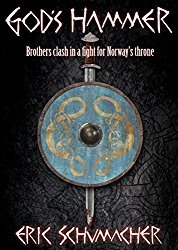
It is 935 A.D. and the North is in turmoil. The Norse king, Harald Fairhair, has died, leaving the High Seat of the realm to his murderous son, Erik Bloodaxe. To solidify his rule, Erik ruthlessly kills all claimants to his throne, save one: his teenage brother Hakon, who is being raised in the Christian courts of Engla-lond. Summoned by the enemies of Erik, young Hakon returns to the Viking North to face his brother and claim his birthright, only to learn that victory will demand sacrifices beyond his wildest nightmares.
What did I make of the book?
Eric Schumacher has created the most evocative tale in his stunning novel — God's Hammer.
Set in 935 AD, God's Hammer tells the story of Hakon Haraldsson (Haakon the Good), from the moment he arrived at King Athelstan of England's Kingdom as a young boy, to the harrowing battle with his eldest brother, Eric Bloodaxe.
This book completely drew me in. The research that has gone into God's Hammer has to be commended, and it is incredibly rich in historical detail. It was as if I was looking through a window into the past as I read the pages of this remarkable story.
Hakon's portrayal is both realistic and believable. Schumacher has obviously researched the life of Hakon in great detail, and this certainly came through in the writing. Schumacher brought Hakon back to life. Well Done!
There are a lot of interesting characters that you meet in this book, and Schumacher has given them all the same attention as Hakon — they are all well-fleshed, and they just work. Everything fits, so well. This book was so refreshing and so realistic, it was an absolute joy to read.
I thought the story itself was gripping and very fast in the telling. It is not an effort to read this book at all. I made a mistake of not giving myself enough time to read it in one sitting because God's Hammer deserves that much attention. It is definitely a sit down and finish book.
I Highly Recommend.
Links for PurchaseAmazon USAmazon UK
About the author
 I grew up in modern Los Angeles but I've had a lifelong love affair with Dark Age Europe. It is a love affair that began as a child, and has persisted through my almost forty years of studying, researching and writing about the subject.
I grew up in modern Los Angeles but I've had a lifelong love affair with Dark Age Europe. It is a love affair that began as a child, and has persisted through my almost forty years of studying, researching and writing about the subject.While I've written a number of articles about technology and travel, God's Hammer is my first novel. The novel tells the true story of King Hakon Haraldsson's bitter fight against his ruthless brother Erik for the Norwegian throne.
I now live in Santa Barbara, a small beach town about 100 miles north of Los Angeles with his family, and split time between writing and managing my own communications agency, Neology.
Published on March 18, 2017 04:10
March 15, 2017
Author’s Inspiration ~ Vanda Vadas #HistFic @Vanda_Vadas
THE PIRATE LORDBy Vanda Vadas

Can love for his beautiful, aristocratic captive rescue Miles from his lust for revenge?
A family tragedy steeped in deceit and betrayal saw Lady Eloise Blakely vow never to fall victim to a man's charms, let alone invite him into her bed. Until fate swept her aboard a pirate's ship and into its captain's embrace.
Yet when he reveals a dark secret, her lover becomes her enemy...
Ten years ago, Miles Zachary Fenton was framed for murder. For so long he has fought to clear his name and reclaim his dukedom. Now, when both appear to be just within reach, he is forced to abduct a meddling beauty, one who wreaks havoc with his emotions and complicates his plans.
Author’s InspirationsMary Anne, it’s an absolute honour and a pleasure to be invited back to your blog site. Thank you!It’s fair to say that I should credit Scottish author Robert Louis Stevenson for sparking my interest and long-held fascination with pirates. You see, for my seventh birthday, my friend gifted me a book, A Child’s Garden of Verses. One of the sixty-five poems contained therein is titled, A Pirate’s Story. When I first read the poem my childhood imagination flew off the radar. I still have that treasured gift.

Fast forward years (and years!) later . . . I received offers from three publishing houses to e-publish my debut book, THE PIRATE LORD. My publisher of choice? Penguin Random House Australia. A few months after the book was published I re-read A Child’s Garden of Verses and noted that (cue music for the Twilight Zone) it had been published by Penguin Books Australia!So, what were some of the real-life inspirations behind the scenes in THE PIRATE LORD – a story of tragedy, murder, deceit, betrayal, revenge, and the inevitable blossoming of love?I’ve been fortunate enough to visit many memorable places around the globe including Waddesdon Manor in Buckinghamshire, England. It was the inspiration behind my opening scene in Chapter One. Imagine if you will, a magnificent house and grounds with dramatic 16thcentury French architecture and grand rooms. The heroine, Lady Eloise Blakely, seeks a moment’s solitude outside, away from the celebrations of her birthday ball when she is confronted by a man who . . .. . . stood at the foot of the terrace steps. Their eyes met. It was not so much his presence that disturbed her, but rather his attire, illuminated well enough by the sconces placed intermittently up the balustrade.Knee-high boots, breeches and shirt melded into one stark splash of black. Ebony hair, neatly tied in a queue, fell past his collar. A wide, black satin mask concealed the upper portion of his features, leaving only the tip of his nose, mouth and jaw exposed. He glanced surreptitiously to his left, towards the gardens, then back at her, past her shoulder, and re-settled his gaze on her face.Fans of Winston Graham’s novels (or the TV series) POLDARK, will recall Cornwall’s picturesque coastline. My travels have taken me to the edge of these granite cliffs where I filled my lungs with crisp, blustery air. I could taste and smell the salty brine as I looked out over the Atlantic Ocean and swept my gaze over the shoreline where waves crashed against jagged rocks. I marvelled at the seagulls, muchlarger than our Aussie breed! This experience, together with the colourful local history, inspired and enriched my scenes set on the Cornwall coast. THE PIRATE LORD explains to his captive . . . ‘We stand at one of many isolated landing places well known to the smuggling brethren. My crew and I do not concern ourselves with the alcohol that lays weighted to the ocean beds. Nor do we disturb the contraband hidden deep inside these coastal caves.’

As you would expect, a book about pirates most likely includes scenes aboard a ship. When Batavia, a replica of the Dutch East Indiaman, was brought to the Australian National Maritime Museum in Sydney, I saw it as the perfect opportunity to step on board and grasp a glimpse of what it might have been like for those above and below deck on a 17thcentury ship. Inspiration struck for a scene where the ship’s cook enlightens Lady Elouise about daily victuals.‘But,’ he continued, ‘if we’re really scraping the bottom of the barrel when it comes to rations, then you might just find one of these on your plate.’ He casually lifted the spoon from the broth, tapped it on the edge of the pot and pointed it at her feet.
Eloise looked down to see a large rat scurry beneath her skirts. She reacted in the manner of a madwoman, stomping on the floor and screaming as if Cook had taken the cleaver to her neck.
A cacophony of female shrieks and raucous male laughter filled the galley.
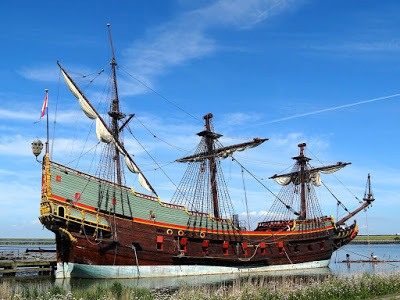
Another opportunity presented itself when my husband and I took a cruise around the Caribbean islands. I scribbled countless pages of notes and took photos and videos of the flora and fauna, of old sugar mills and plantation houses. Being there and taking it all in was the perfect way to see and sense my surrounds just as Eloise does . . .
Two large mountains jutted out from the ground at either end of the island. A valley stretched in between. Sand whiter than blanched almonds edged the shores. Her gaze swept the layers of colour, from the lush green vegetation and sun-bleached sands, to the vast blue-green of the ocean. She sniffed the warm air, a fragrant mixture of sweet florals, spice and earthy plant life.On the island of Dominica, we walked through a lush green tropical rainforest to find a breathtaking hidden jewel with its beautiful waterfall, aptly named Emerald Pool. This was inspiration at its best and I knew I’d found the perfect location for a pivotal, intimate love scene in my book.Enjoy!
Links to PurchaseAMAZON UKAMAZON USAMAZON AUiBOOKSKOBO
About the author
 Before residing in Australia, Vanda’s birthplace and early childhood years were spent in Papua New Guinea. At the age of eleven, a holiday in England sparked an interest in the days of old. Castles, ruins, and discovering Jane Austen novels inspired a life-long interest in all things historical, a passion that later kick-started Vanda’s desire to write historical romance.
Before residing in Australia, Vanda’s birthplace and early childhood years were spent in Papua New Guinea. At the age of eleven, a holiday in England sparked an interest in the days of old. Castles, ruins, and discovering Jane Austen novels inspired a life-long interest in all things historical, a passion that later kick-started Vanda’s desire to write historical romance.Vanda has studied and worked in the field of Education, teaching English Literacy and Numeracy to children and adults. She’s also worked as a recruitment consultant and as a PA.
Vanda and her husband live on the Gold Coast in Queensland where they enjoy walks along world-renowned beaches or a quiet getaway to the lush hills of the Hinterland.Useful LinksWebsite: http://www.vandavadas.com/ Facebook: Vanda Vadas Author Twitter: @Vanda_Vadas
Published on March 15, 2017 00:00
March 14, 2017
Video #bookreview ~ The Du Lac Chronicles #Arthurian #historicalfantasy @CrankyTBC
<!-- /* Font Definitions */ @font-face {font-family:Times; panose-1:2 0 5 0 0 0 0 0 0 0; mso-font-charset:0; mso-generic-font-family:auto; mso-font-pitch:variable; mso-font-signature:3 0 0 0 1 0;} @font-face {font-family:"MS 明朝"; mso-font-charset:78; mso-generic-font-family:auto; mso-font-pitch:variable; mso-font-signature:-536870145 1791491579 18 0 131231 0;} @font-face {font-family:"Cambria Math"; panose-1:2 4 5 3 5 4 6 3 2 4; mso-font-charset:0; mso-generic-font-family:auto; mso-font-pitch:variable; mso-font-signature:-536870145 1107305727 0 0 415 0;} @font-face {font-family:Cambria; panose-1:2 4 5 3 5 4 6 3 2 4; mso-font-charset:0; mso-generic-font-family:auto; mso-font-pitch:variable; mso-font-signature:-536870145 1073743103 0 0 415 0;} /* Style Definitions */ p.MsoNormal, li.MsoNormal, div.MsoNormal {mso-style-unhide:no; mso-style-qformat:yes; mso-style-parent:""; margin:0cm; margin-bottom:.0001pt; mso-pagination:widow-orphan; font-size:12.0pt; font-family:Cambria; mso-ascii-font-family:Cambria; mso-ascii-theme-font:minor-latin; mso-fareast-font-family:"MS 明朝"; mso-fareast-theme-font:minor-fareast; mso-hansi-font-family:Cambria; mso-hansi-theme-font:minor-latin; mso-bidi-font-family:"Times New Roman"; mso-bidi-theme-font:minor-bidi;} .MsoChpDefault {mso-style-type:export-only; mso-default-props:yes; font-family:Cambria; mso-ascii-font-family:Cambria; mso-ascii-theme-font:minor-latin; mso-fareast-font-family:"MS 明朝"; mso-fareast-theme-font:minor-fareast; mso-hansi-font-family:Cambria; mso-hansi-theme-font:minor-latin; mso-bidi-font-family:"Times New Roman"; mso-bidi-theme-font:minor-bidi;} @page WordSection1 {size:612.0pt 792.0pt; margin:72.0pt 90.0pt 72.0pt 90.0pt; mso-header-margin:36.0pt; mso-footer-margin:36.0pt; mso-paper-source:0;} div.WordSection1 {page:WordSection1;} --</style><span style="font-family: "times"; font-size: 28.0pt;"> </span><span style="font-family: "times"; font-size: 14.0pt;">I just had to share this amazing review of The Du Lac Chronicles by </span><span style="font-family: "times"; font-size: 14.0pt;">Cranky The Book Curmudgeon ~ it quite literally brought tears to my eyes! Check it out, it is awesome!!</span><br /><br /><div class="separator" style="clear: both; text-align: center;"></div><div class="separator" style="clear: both; text-align: center;"><iframe allowfullscreen="" class="YOUTUBE-iframe-video" data-thumbnail-src="https://i.ytimg.com/vi/y-E3tcL7Sx4/0.jpg" frameborder="0" height="266" src="https://www.youtube.com/embed/y-E3tcL..." width="320"></iframe></div><br /><br /><span style="font-family: "times"; font-size: x-large;">Links for Purchase</span><br /><br /><a href="https://www.amazon.com/Du-Lac-Chronic... style="font-family: "times"; font-size: x-large;">Amazon US</span></a><br /><br /><a href="https://www.amazon.co.uk/Du-Lac-Chron... style="font-family: "times"; font-size: x-large;">Amazon UK </span></a><br /><br /><span style="font-family: "times"; font-size: x-large;"> </span> </div>
Published on March 14, 2017 00:54
March 13, 2017
#bookreview ~ The Complete King Arthur: Many Faces, One Hero #Arthurian
The Complete King Arthur:
Many Faces, One Hero
ByJohn Matthews & Caitlín Matthews
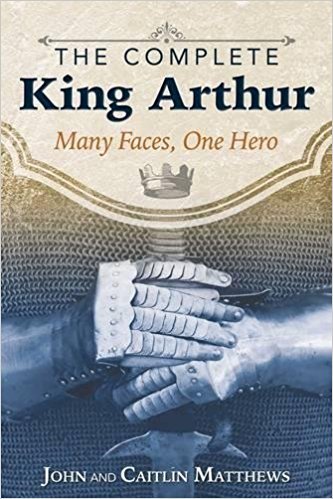
A comprehensive examination of the historical and mythological evidence for every major theory about King Arthur
• Explores the history of every Arthur candidate and the geographical arguments that have placed him in different locations
• Examines 1,800 years of evidence for Arthur’s life and the famous series of 12 battles fought against the Saxons in the 6th century
• Reconstructs the history of the 6th century in Britain, when the first references to Arthur and the core events of his reign appear
Few legends have had the enduring influence of those surrounding King Arthur. Many believe the stories are based on historical truth. For others Arthur represents the archetype of the brilliant monarch reigning over a fairy-tale kingdom, offering his knights the opportunity to prove their mettle in battle and find gnostic illumination through initiation into sacred mysteries like that of the Grail.
Presenting the culmination of more than 40 years’ research, John and Caitlín Matthews examine the historical and mythological evidence for every major theory about the existence of King Arthur. Drawing on modern techniques in archaeology and scholarship, they reconstruct the history of the 6th century in Britain, the period when the first unambiguous references to Arthur appear. They explore the history of every Arthur candidate, the geographical arguments that have placed him in different locations, and the evidence for his life and famous battles fought against the Saxons. Was the greatest British hero of all time not a king but a 2nd-century Roman officer active around Hadrian’s Wall in Cumbria? A 5th-century soldier who operated in areas as far apart as Cornwall, Wales, Scotland, or Brittany? Or an entirely mythical fiction that provided a figure of light during a dark period of British history?
Examining other literary figures from the 5th century such as Vortigern and Ambrosius, the authors also break down the plots of all the major Arthurian romances, including those by Chretien de Troyes, Sir Thomas Malory, and Robert de Boron, to reveal the historical events they are based on. Piecing together the many fragments that constitute the image of Arthur, both the man and the myth, the authors show how each face of Arthur has something to offer and how his modern popularity proves the enduring power of the hero-myth, truly earning Arthur the title he first received in the 15th century: The Once and Future King.
What did I think of the book?
The Complete King Arthur: Many Faces, One Hero, is a comprehensive look at the many different persona’s of King Arthur. I have read many books from notable scholars on the subject of Arthur, so I was looking forward to seeing what John Matthews and Caitlín Matthews had to say for themselves. I was hoping for something fresh and easy to read, I got that.
The authors do not claim to have found Arthur, this isn’t that type of book, although I got the impression the authors were leaning towards the Roman Centurion, Artorius Castus, as a probable candidate!
This book covers a vast period, from Roman occupation of Britain, to now, which is a long period of history to cover, but I have to commend John Matthews and Caitlín Matthews, for they did it remarkably well.This book looks at how Arthur has changed through the ages and how he has been used, to some extent, for political purposes. It also shows us how Arthur ‘the man’ was turned into Arthur ‘the legend’ and how the ancient texts were possibly misinterpreted. So as with anything to do with Arthur you expect to look at the works of Gildas, Nennius, Bede, etc... which this book does, and John Matthews and Caitlín Matthews have come up with some really interesting thesis as they interpret what they think this writing is, and isn’t, telling us. The authors arguments are very compelling, and I have to admit I had this book in one hand, and the rest of my vast Arthurian collection spread out before me while I cross-referenced. And for the most part, I found myself agreeing with what John Matthews and Caitlín Matthews have so elegantly put forward as an argument. Their interpretation makes sense.
This book spends a long time looking at Nennius’s 12 famous battles and how these "battles" have been interpreted / miss-interpreted over time, and, more importantly, what they say about the political landscape that they are set in. I thought the authors were right to dedicate this amount of time to these battles and for those new to Arthurian Legend this would be enlightening.
The book takes us on a journey and show us how Arthur changed over time from a soldier to a king, and it pays particular attention to the great poets, who of course, were responsible for this change. There is a fascinating chapter on Geoffrey of Monmouth, who is the founding father of the somewhat fictitious Arthur that we would recognise today. The authors look in great detail at Monmouth’s life and where he got his facts from - that missing ancient manuscript raises its head again - and more importantly, they look at why Monmouth wrote it in the first place.
The authors show the two sides of Arthur — the Christian King, and the spoilt, arrogant, almost evil Arthur that he was sometimes portrayed as. The book looks at principle players in Arthurian Legend as well - Kay, Mordred, Bedivere, Gawain, and Lancelot, as well as Arthur's Queen, all get a mention and as with Arthur, the authors demonstrate where the 'historical' characters came from, and which ones have a rather fictitious beginning!
I thought this book was very well thought out, there are lots of amazing images,a very useful timeline, maps, and everything is chronicled in order, so you reallydo need to start at the beginning as there is a lot of references to earlier chapters. This is a book that is suitable for those who are just starting out on theirArthurian journey, as well as those that are well on their way into their research.This is a book that I am going to come back to again. It is a welcomed additionto my shelf.
I Highly Recommend.
*I received an ARC of this book via Netgalley, for review consideration*
Links for PurchaseAmazon USAmazon UKB&N
Many Faces, One Hero
ByJohn Matthews & Caitlín Matthews

A comprehensive examination of the historical and mythological evidence for every major theory about King Arthur
• Explores the history of every Arthur candidate and the geographical arguments that have placed him in different locations
• Examines 1,800 years of evidence for Arthur’s life and the famous series of 12 battles fought against the Saxons in the 6th century
• Reconstructs the history of the 6th century in Britain, when the first references to Arthur and the core events of his reign appear
Few legends have had the enduring influence of those surrounding King Arthur. Many believe the stories are based on historical truth. For others Arthur represents the archetype of the brilliant monarch reigning over a fairy-tale kingdom, offering his knights the opportunity to prove their mettle in battle and find gnostic illumination through initiation into sacred mysteries like that of the Grail.
Presenting the culmination of more than 40 years’ research, John and Caitlín Matthews examine the historical and mythological evidence for every major theory about the existence of King Arthur. Drawing on modern techniques in archaeology and scholarship, they reconstruct the history of the 6th century in Britain, the period when the first unambiguous references to Arthur appear. They explore the history of every Arthur candidate, the geographical arguments that have placed him in different locations, and the evidence for his life and famous battles fought against the Saxons. Was the greatest British hero of all time not a king but a 2nd-century Roman officer active around Hadrian’s Wall in Cumbria? A 5th-century soldier who operated in areas as far apart as Cornwall, Wales, Scotland, or Brittany? Or an entirely mythical fiction that provided a figure of light during a dark period of British history?
Examining other literary figures from the 5th century such as Vortigern and Ambrosius, the authors also break down the plots of all the major Arthurian romances, including those by Chretien de Troyes, Sir Thomas Malory, and Robert de Boron, to reveal the historical events they are based on. Piecing together the many fragments that constitute the image of Arthur, both the man and the myth, the authors show how each face of Arthur has something to offer and how his modern popularity proves the enduring power of the hero-myth, truly earning Arthur the title he first received in the 15th century: The Once and Future King.
What did I think of the book?
The Complete King Arthur: Many Faces, One Hero, is a comprehensive look at the many different persona’s of King Arthur. I have read many books from notable scholars on the subject of Arthur, so I was looking forward to seeing what John Matthews and Caitlín Matthews had to say for themselves. I was hoping for something fresh and easy to read, I got that.
The authors do not claim to have found Arthur, this isn’t that type of book, although I got the impression the authors were leaning towards the Roman Centurion, Artorius Castus, as a probable candidate!
This book covers a vast period, from Roman occupation of Britain, to now, which is a long period of history to cover, but I have to commend John Matthews and Caitlín Matthews, for they did it remarkably well.This book looks at how Arthur has changed through the ages and how he has been used, to some extent, for political purposes. It also shows us how Arthur ‘the man’ was turned into Arthur ‘the legend’ and how the ancient texts were possibly misinterpreted. So as with anything to do with Arthur you expect to look at the works of Gildas, Nennius, Bede, etc... which this book does, and John Matthews and Caitlín Matthews have come up with some really interesting thesis as they interpret what they think this writing is, and isn’t, telling us. The authors arguments are very compelling, and I have to admit I had this book in one hand, and the rest of my vast Arthurian collection spread out before me while I cross-referenced. And for the most part, I found myself agreeing with what John Matthews and Caitlín Matthews have so elegantly put forward as an argument. Their interpretation makes sense.
This book spends a long time looking at Nennius’s 12 famous battles and how these "battles" have been interpreted / miss-interpreted over time, and, more importantly, what they say about the political landscape that they are set in. I thought the authors were right to dedicate this amount of time to these battles and for those new to Arthurian Legend this would be enlightening.
The book takes us on a journey and show us how Arthur changed over time from a soldier to a king, and it pays particular attention to the great poets, who of course, were responsible for this change. There is a fascinating chapter on Geoffrey of Monmouth, who is the founding father of the somewhat fictitious Arthur that we would recognise today. The authors look in great detail at Monmouth’s life and where he got his facts from - that missing ancient manuscript raises its head again - and more importantly, they look at why Monmouth wrote it in the first place.
The authors show the two sides of Arthur — the Christian King, and the spoilt, arrogant, almost evil Arthur that he was sometimes portrayed as. The book looks at principle players in Arthurian Legend as well - Kay, Mordred, Bedivere, Gawain, and Lancelot, as well as Arthur's Queen, all get a mention and as with Arthur, the authors demonstrate where the 'historical' characters came from, and which ones have a rather fictitious beginning!
I thought this book was very well thought out, there are lots of amazing images,a very useful timeline, maps, and everything is chronicled in order, so you reallydo need to start at the beginning as there is a lot of references to earlier chapters. This is a book that is suitable for those who are just starting out on theirArthurian journey, as well as those that are well on their way into their research.This is a book that I am going to come back to again. It is a welcomed additionto my shelf.
I Highly Recommend.
*I received an ARC of this book via Netgalley, for review consideration*
Links for PurchaseAmazon USAmazon UKB&N
Published on March 13, 2017 00:00
March 8, 2017
Author’s Inspiration ~ Cathy Skendrovich #HistFic @cskendrovich
The Pirates BrideBy Cathy Skendrovich

All Sophie Bellard wants is her freedom, freedom to sail the seven seas, and freedom to be her own person without interference from a controlling husband. But an arranged marriage to handsome and dangerous Captain Andre Dubois derails all her hopes. After a disastrous wedding night where a ruinous secret is discovered, the two go their separate ways with hopes of never meeting again.Sophie becomes a pirate while Andre sets off for the Orient, where he makes a murderous enemy. After escaping with his life, Andre returns to home waters, and in an unexpected twist of pirate fate, reunites with his estranged and unwilling wife.When Andre’s murderous enemy threatens Sophie’s life, he vows to protect what is his, and attempts to win his wife’s forgiveness and love, once and for all.
Author’s Inspiration“Well, Capitán, let me pose you a question about this topic. Which is the strongest action, the most enduring: making love, being in love, or simply loving? Perhaps when you find the answer to that you will know how deep your feelings run for your wife, eh?” ~ from The Pirate’s Bride
Love. Everyone feels it for someone. Spouse, significant other, child, parents, siblings, friends. Love is a universal emotion that has often been suggested to run the world. It’s what romance authors write about in millions of books, and what just as many readers devour by the page. You’d think the subject has been discussed until there is no room for new ideas. But you’d be wrong. Love is a unique feeling to every individual, and that’s what romance authors tap into. That uniqueness to every single reader. My love for my husband may be similar to someone else’s love for their husband, but in no way is it exactly the same.So, too, are romance novels. Boy meets girl, they fall in love, one of them has a problem that must be solved, they live happily ever after is the story arc that all romance novels adhere to, yet every book is unique, just like the feeling of love is unique to each reader. Every writer strives to make his or her story just a bit different than all the others out there, and they usually succeed.And that is the same with me. When I set out to write The Pirate’s Bride, it was right after the third POTC movie came out, where Captain Jack Sparrow sails off into the sunset alone. I didn’t like that ending. After three movies, I felt the good captain deserved a love interest. The audiencedeserved a love scene! And so, I began to write.Captain Andre Dubois started out in my head looking like Johnny Depp, but soon he took on his own persona. No dreadlocks for him; he wears shoulder-length hair that he ties into a queue on occasion. His garb is traditional pirate gear, and he uses kohl to deflect the sun’s rays. But that’s as close as he comes to Captain Jack.Andre is a French pirate, like Jean Lafitte, whom I researched at length. His home base is New Orleans, but he’s happiest at sea. He speaks English and French fluently, interspersing both languages. I had a lot of fun looking up words in French, and getting help from French-speaking friends to make sure my words were correct.

I studied the POTC films and other pirate romance novels, wanting to make my book stand out from what has gone before. I didn’t want my pirate to be a displaced lord, or a privateer or mercenary. There are enough romances like that. I didn’t want him like Captain Jack, too childlike to sustain a romance. I wanted him to be a real pirate. I wanted an Alpha male who could still learn to love. Once I had Captain Andre Dubois, I turned to his love interest. He needed a strong woman, one who could stand up to his Alpha ways. Just like Andre is no Captain Jack, Sophie Bellard is no Elizabeth Swann. Sophie has insecurities that she must overcome before she can become a pirate. And that’s what sets her apart from most other pirate romance heroines. Sophie is a pirate. She isn’t a stowaway, or a captured passenger. She is a female buccaneer.I took a lot of her personality from what I would want to be as a female pirate: fearless and brave. Able to stand up to men, sail the ocean blue, yet still remain feminine. Once again, I turned to movie heroines, picking and choosing traits from women I admired in movies. Sophie is a little like Evelyn in The Mummy, a bit like Elizabeth Swann in POTC, and, believe it or not, just a smidge of Scarlett in Gone with the Wind (that female character doesn’t know the meaning of the word no). Sophie Bellard became the perfect love interest for larger-than-life Andre Dubois.Their story isn’t like any other pirate story out there. They argue passionately, they fight passionately, and they love passionately. So, when researching passionate couples, I turned to movies once more. Think Han Solo, and the late, great Princess Leia (Carrie Fisher). Or Scarlett and Rhett Butler. Couples who don’t seem to get along on the surface, yet they can’t be apart. They’re like magnets that slam together with the force of their love.My inspiration for writing my new release, The Pirate’s Bride, came from a variety of entertainment sources. Movies, books, history, and real life all played a part in the creation of this novel. I’d like to think that the world I invented, the story I told, is one-of-a-kind. Ultimately, it’s up to readers to decide. I look forward to hearing what you think about Captain Andre Dubois and his lady love, Captain Sophie Bellard, and their love story within the pages of The Pirate’s Bride.
Links for PurchaseAmazonPaperback
About the author
 Cathy Skendrovich has always loved a good story, and spent her formative years scribbling what is now called Fan Fiction. The current heartthrob of the time featured heavily in all her stories. Unfortunately, once she went to college, her writing took the form of term papers.
Cathy Skendrovich has always loved a good story, and spent her formative years scribbling what is now called Fan Fiction. The current heartthrob of the time featured heavily in all her stories. Unfortunately, once she went to college, her writing took the form of term papers.Upon graduation, Cathy became a middle school English teacher. Along the way, she married her husband of now thirty-two years, had two sons, and moved to southern Orange County, California. She chose to work part-time in the school system there.
She eventually joined the online writing site, Wattpad, and won a 2012 Watty Award for The Pirate’s Bride. She is now a featured author on that site, and credits her Wattpad follows for encouraging her to become a published author. Her published books, Prisoner of Love and The Pirate’s Bride, both debuted there.The sequel to The Pirate’s Bride, a novella entitled A Pirate’s Bride Christmas, will be published later this year by Literary Wanderlust, while her next contemporary romantic suspense, Protecting the Nanny, will come out sometime in 2018, from Entangled Publishing.Useful LinksWebsite: http://www.cathyskendrovich.com/Facebook: https://www.facebook.com/Cathy-Skendrovich-249667925220631/Twitter: https://twitter.com/cskendrovichGoodreads: https://www.goodreads.com/author/show/14232546.Cathy_Skendrovich
Published on March 08, 2017 00:00
March 5, 2017
#bookreview ~ The Devil And The Deep Blue Sea #histfic @JohannaCraven
The Devil And The Deep Blue SeaByJohanna Craven
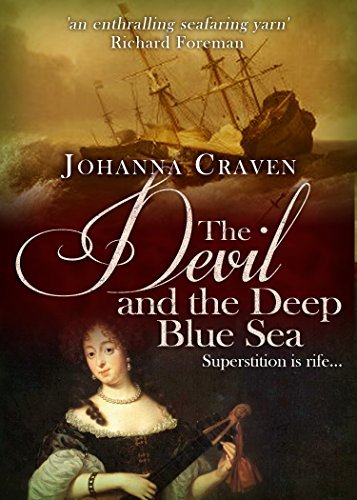
1692. The Atlantis, captained by veteran seaman Benjamin Archer, flies the colours of an English merchantman on the high seas between the English Channel and the Caribbean.
But she also runs up the ‘jolie rouge’ – the Jolly Roger – whenever the prospect of plundering a Spanish treasure ship presents itself.
Nipping at Spain’s empire is common practice for state-sponsored privateers like the Atlantis at a time when lesser European powers dare not directly make war on Spain.
But when those governments abandon the practice of issuing letters of marque to privateers against the Spanish galleons, many of the crews turn pirate.
Such is the fate of Archer’s men.
The crew is forced to sign the ship’s articles consenting to their new piratical ways, thereby placing their heads in a noose.
Unless, that is, they can stage a mutiny and turn Archer over to the authorities in the Caribbean city of Port Royal, a popular homeport for privateers – and notorious for its gaudy displays of wealth and loose morals, the ‘wickedest city on earth’.
But superstition is rife among seamen and the presence on board the Atlantisof two women – one a high-born French stowaway Catherine and the other a Jamaican slave-born ‘cabin boy’ Serafine – will only be a bad omen if they are discovered.
Worse, the runaway is thought by her family to possess the powers of a witch while the ‘boy’ worships voodoo gods who rule life from beneath the waves.
Will the mutiny succeed?
What is the secret bond between Archer and Serafine?
And can Catherine escape the captain’s determination to make her his after she has fallen for another young officer?
Is some unstoppable divine force slowly gathering to punish the profane?
Johanna Craven’s impressive latest novel combines the island paradise world of Mutiny on the Bounty with the visual and visceral immediacy of Master and Commander, whilst also delving into the legacies of colonialism explored in Joseph Conrad’s sinister Heart of Darkness.
Beyond the power and control of man lies what …?
What did I think of the book?
I am an avid reader of historical fiction, and I think because of this I have set the bar very high. The Devil And The Deep Blue Sea is so far passed the bar that it is in another hemisphere. This is an extraordinary work of historical fiction, and I don't say that lightly. It really did blow me away.
The characters were fresh and beautiful portrayed. This story is driven by several key protagonists, who each have their own desperate backstory and somehow, against the odds, they have all ended up on the same ship — some willingly, others not so. And despite their suspicion of each other, they know that they cannot survive without the others. There is a real sense of desperation in this story and about the want for something better. Craven has portrayed the human spirit with great proficiency and believability. There is also a love story here, which touched my heart and I was really gunning for the characters to have a happy ever after, but with the explosive ending I wasn't sure they were going to get it.
The prose in this book is a work of art — fabulous storytelling. I cannot stress how good this book is. It ticked all my boxes and then some.
I applaud Craven for bringing such a well researched and breathtaking story into the world. This is a must read, if ever there was one.
I Highly Recommend.
Links for PurchaseAmazon USAmazon UK
About the author

Johanna Craven is an Australian-born writer of historical and new adult fiction. She is also a film composer, music teacher and pianist. She has lived in Melbourne and Los Angeles and is currently based in London.
Her more questionable hobbies include ghost hunting, meditative dance and pretending to be a competitor on The Amazing Race when travelling abroad. Check out Johanna's books and music at www.johannacraven.com
Published on March 05, 2017 08:59
March 2, 2017
Robin Hood and his Merry Men ~ Friar Tuck #Sherwood #folklore
Last time I looked at Little John and his place in the legend that is Robin Hood. Today, I want to look at another colourful character — Friar Tuck!
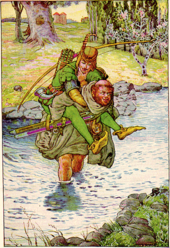 llustration by Louis Rhead
llustration by Louis RheadThe Friar who had a rather large girth, a jolly countenance and was, without a doubt, an all round good egg — be it that he was an outlaw. But hey, I guess he could multitask.
Friar Tuck really came into his own in the 15th Century, the same time Maid Marion did. Tuck, like Marion, was part of the May Day celebrations. Our Medieval ancestors loved everything Robin Hood and what better than a monk who had thrown in his lot with a band of outlaws because he could see the injustice around him and he wanted to make a difference. It is all rather romantic, isn't it?
But, is there any truth in it?
Let us rewind a little. There was a Robert Hoodwho was getting into trouble with the law in 1225. Which would put him in the reign of Henry III, but if we stick to the legend we are going back even further to the reign of Richard I. Confused? Yes, I am!
Let's try and figure out who this Friar Tuck was — if he was real at all. Let's start with the obvious — he was a Friar. It is a bit of a giveaway really, isn't it?! It is, after all, in his name.
But what kind of Friar?I think there are two possibilitiesFranciscans (Founded 1209)Dominicans (Founded 1216)
But look at those dates. The legend kind of runs into trouble here because when Richard I ruled there were no Friars in England — they had not even been founded yet. Now that is just not cricket. I feel all disappointed now. We can’t have a Robin Hood without a Friar Tuck.
Let's fast-forward back to the early 15th Century, and here we meet a man called Richard Stafford, a chapman in Lindfield, Sussex. But he wasn’t the most honest of chapman’s. He had another side to him, an alias that so happened to be, yeah, you guess it, "Friar Tuk.”
I am rubbing my hands in glee, are we getting somewhere? This "Friar" who was running around in the reign of Henry V was quite the criminal, stealing from the king's lieges, burning foresters home, poaching, etc…
So the question has to be asked, was Stafford borrowing the allies? Was he modelling himself on a real Friar Tuck who was running around Sherwood in the 12th Century? Or has the legend of a Friar Tuck developed over the years from this 15th Century outlaw?
Questions. Questions. Questions. Are there any answers? Nothing definite, but we are dealing with legends, and they wouldn't be legends if we could pin historical fact to them would they?
Fascinating stuff, though.
Published on March 02, 2017 00:00
March 1, 2017
Author's Inspiration ~ Nancy Jardine #HistFic @nansjar
It is with the greatest of pleasures that I welcome historical fiction author, Nancy Jardine, on to the blog today. Nancy is going to tell us all about her inspirations behind her fabulous Celtic Fervour Series...
The Beltane Choice (Celtic Fervour Series Book 1)

Can the Celtic Tribes repel the Roman army?AD 71—Banished from the nemeton, becoming a priestess is no longer the future for Nara, a princess of the Selgovae tribe. Now charged with choosing a suitable mate before Beltane, her plan is thwarted by Lorcan, an enemy Brigante prince, who captures her and takes her to his hill fort. Despite their tribes fighting each other, Nara feels drawn to her captor, but time runs out for her secret quest.As armies of the Roman Empire march relentlessly northwards, Lorcan intends to use Nara as a marriage bargain, knowing all Celtic tribes must unite to be strong enough to repel imminent Roman attack. Nara’s father, Callan, agrees to a marriage alliance between Selgovae and Brigante, but has impossible stipulations. Lorcan is torn between loyalty to his tribe and growing love for Nara.When danger and death arrive in the form of the mighty Roman forces, will Nara be able to choose her Beltane lover?
Author's Inspiration

10,000 Ancient Roman soldiers trampling all over my garden! My heart pumped double time to the beat of their double pacing when I learned that. The progress of those marching hob-nailed caligae (boots) would have completely ruined my current lawns and shrub displays but to say that I was jumping for joy is a massive understatement. My compulsion to write about it began and hasn’t stopped.
I imagined men toiling nearby, specialist soldiers in the vanguard of the long legionary march whose job was to labour with dolabra (pickaxe), or shovel that they carried on their back. I envisaged them digging the ditches, creating the ramparts of the almost rectangular site that was marked out by ground engineers using their gromas (surveying equipment). The ting on metal rang as the tools hit stones. The rippling tinkles of the lorica segmentata (breastplate armour) and duller clunks of the lorica hamata (chain mail) as the men bent and stretched to heave the excavated soil over to what became the earthwork fortifications were heard close by. I could smell their sweat: maybe more unpleasant body odours. Turf cutters and scythes were being whacked around to clear the interior of obstructions so that pitching tents would be on relatively flat ground.
There was a noisy bunch gathering water supplies from the nearby River Don. Others were felling trees, the wood necessary for their cooking fuel and fires to warm them during the cool nights of early autumn. Far off screams and close-to-death pleas were the result of troops ridding the area of local tribespeople: those too old, too young, or too infirm to flee their roundhouses when the earthquake rumble of thousands of Roman treads approached them.
Creating Ancient Roman marching camps was a highly-skilled, slick operation completed in a surprisingly short time—perhaps less than two hours depending on the terrain—by men who had just trekked around twelve miles from the previous camp.
The images continued… and I used them to inspire my 11-12 year old primary pupils to write fantastic end-of-topic short stories for me. Their task: to take on the mantle of an indigenous early teen (boy or girl) and fictionalise what happened to them when the 10,000 strong Roman fighting machine descended on their roundhouse village at Balbithan, near my village of Kintore in Aberdeenshire, Scotland. (There really was a late iron age roundhouse settlement there)
And it’s completely true to say that their excellent stories of the Roman invasion of Aberdeenshire, in turn, inspired me to write my own novels set in Roman Britain.
Aberdeenshire, Scotland, is littered with remnants of ancient history. Neolithic long barrows, stone circles, and Pictish symbol stones are a-plenty. There are ruined and lived-in castles but there are also archaeological gems that are much less visible. The sites of Celtic hillforts and Ancient Roman temporary camps are hardly discernible at all but it doesn’t mean they’re any less interesting. The imagination just has to work a little harder.
Parts of the ramparts and ditches of the Kintore Ancient Roman temporary camp were recorded by amateur enthusiasts during the early Victorian era. However, in the way of agricultural progress, the rampart evidence was mostly ploughed out over the ensuing decades. Even worse from the historian’s point of view, a village primary school was built on the south-eastern corner of the camp in 1875—that building being right across from my house and garden.

Skip forward to 2002. I was teaching 11-12 year olds in that Victorian school building, which by then was too old and impractical. Archaeologists had been drafted in to survey the field areas behind the school prior to new housing and a brand new primary school being built. By 2004, the archaeologists confirmed that the Kintore Roman camp had been used by the legions of General Gnaeus Julius Agricola c. AD 84, during his northern Britannia campaigns. They believed the same area was probably also used by Emperor Severus c. AD 210—when he marched north to ‘teach the tribes of the north a lesson’ (some experts believe genocide was his aim). A third occupation is also possible, though by an unknown commander. When I discovered that the south-eastern corner of that Kintore camp was about 30 paces from my house, I was utterly hooked on researching Roman Britain and I’ve been enthralled ever since.
In 2004, my 11-12 year old pupils spent one term learning about the Roman invasions of Aberdeenshire. I’d taught ‘Romans and Celts’ to younger classes and had a good basic knowledge, but with older pupils my task was harder when it came to researching information to slake their interest (and mine). Pre-history is notoriously short on written sources.
The main source is De vita et moribus Iulii Agricolae’ (On The Life and Character of Julius Agricola) by Cornelius Tacitus, the son-in-law of Agricola. Though Tacitus’ writing is thought by many to be biased and over political— and all we have to go on are c.14th century copies of it and not the original—it’s the only source of the Agricolan campaigns that’s available, apart from a couple of small mentions by other ancient writers (Cassius Dio). Armed with Tacitus, and the most recent invaluable archaeological evidence, my class and I had great fun exploring the topic. When I couldn’t find a suitably local ‘Roman/ Celt’ novel to share with my class, I vowed to write one myself, someday. It didn’t happen immediately but in the fullness of time…
Book 1 of my Celtic Fervour Series was published in 2012. The series begins in what is currently Yorkshire and Cumbria in England, Brigante territory which Agricola had to subdue first before marching northwards into what is now Scotland. By Book 3 of the series, Agricola is confronting the local tribes in pitched battle at Beinn na Ciche in ‘Aberdeenshire’, in AD 84. I’m currently working on Book 4 where educated guesswork, and a reliance on up-to-date archaeological evidence, has to spark my imagination entirely because Tacitus wrote nothing of the longer term aftermath of the battle which he called Mons Graupius. Though my novels are largely written from the viewpoint of my ‘Celtic’ clan characters, there are secondary Roman ones from Book 2 onwards, and in Book 4 Agricola plays a strong role.

The Taexali Game is a Time Travel adventure for early teens, and anyone older who loves a rollicking adventure story. In it, a trio of kids from Kintore whiz back to AD 210 when the Ancient Roman Emperor Severus marched into Aberdeenshire with 30,000 troops. (Yes! A whole lot more than Agricola had) The Taexali Game was published in 2015—four years after I stopped teaching but it is dedicated to those pupils of 2004 who inspired me.
Though my work is fiction, my aim has always been to create credible characters in the most authentic possible settings and situations. I’m absolutely delighted to read the Amazon reviews which highlight that aim.
I’m still learning about the Ancient Roman Empire and don’t intend to stop!
Links for Purchase Amazon
About the author
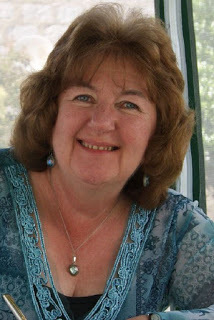 Nancy Jardine’s writing spans the different genres of historical romantic adventure and contemporary romantic mysteries which are set in fabulous world-wide cities, Topaz Eyes being a finalist in The People’s Book Prize 2014. The Taexali Game, her early teen time-travel adventure, is set in third century Roman Scotland. Regular grandchild-minding, gardening, reading, writing, social media marketing and blogging take up her week—though not necessarily in that order. Keeping abreast of Roman Scotland archaeological developments is invaluable for the local presentations she gives on her novels, and on Roman Scotland. Regular book signing & selling sessions at Craft Fairs are great fun. Watching TV Drama and the news are luxuries, as are social events with friends and family, though they’re creatively squeezed in. An ex-primary teacher, she continues to learn something new every day and recently completed a fantastic course on Hadrian’s Wall! She’s a member of the Romantic Novelists Association and the Scottish Association of Writers.
Nancy Jardine’s writing spans the different genres of historical romantic adventure and contemporary romantic mysteries which are set in fabulous world-wide cities, Topaz Eyes being a finalist in The People’s Book Prize 2014. The Taexali Game, her early teen time-travel adventure, is set in third century Roman Scotland. Regular grandchild-minding, gardening, reading, writing, social media marketing and blogging take up her week—though not necessarily in that order. Keeping abreast of Roman Scotland archaeological developments is invaluable for the local presentations she gives on her novels, and on Roman Scotland. Regular book signing & selling sessions at Craft Fairs are great fun. Watching TV Drama and the news are luxuries, as are social events with friends and family, though they’re creatively squeezed in. An ex-primary teacher, she continues to learn something new every day and recently completed a fantastic course on Hadrian’s Wall! She’s a member of the Romantic Novelists Association and the Scottish Association of Writers.You can find her at these places: Blog http://nancyjardine.blogspot.co.uk Website http://nancyjardineauthor.com/ Facebook http://on.fb.me/XeQdkG& http://on.fb.me/1Kaeh5G Email nan_jar@btinternet.com Twitter @nansjar Amazon Author page http://viewauthor.at/mybooksandnewspagehere
Published on March 01, 2017 00:00
February 27, 2017
#bookreview ~ Once Upon a Summer Night #Romance #timetravel @NancyScanlon1
Once Upon a Summer Night:Mists of Fate - Book ThreeByNancy Scanlon
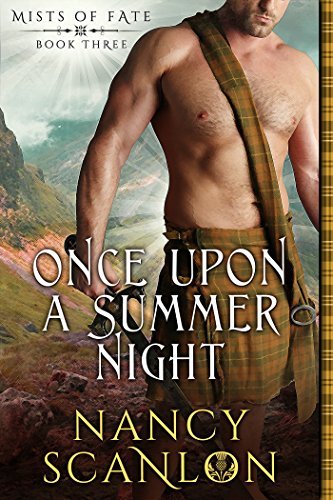
Colin O’Rourke’s elite matchmaking service is taking off until Winifred Emsworth, Great Britain’s most influential gossip columnist, writes a scathing article about it. She’ll retract the column…if Colin can match her shy, bookish niece with a modern British aristocrat.
But that’s not Colin’s only problem. As one of the O’Rourke time-traveling Guardians, Colin’s destined for one woman only. His thinks he’s found her when she wanders into his cousin’s garden, but she leaves before he can get her name. If he doesn’t track her down again, he’ll never know true love.
Eleanor Carberry is happy with her life as a bookshop owner, and she knows she has her dear aunt Winifred to thank for it—especially as Winnie helped smooth over a very public breakup and a very personal loss. Her aunt has never expected anything in return, so when she asks Ellie to help vet an American matchmaking company, Ellie reluctantly agrees.
When Colin and Ellie meet, Colin realizes she’s the woman from the garden. He’s bound by contract to find her an Englishman, or he’ll lose the business he’s worked so hard to grow. Despite the distance he tries to keep between them, Fate has other plans when Ellie takes an unexpected trip back in time—once upon a summer night.
What did I think of the book?
From cosmopolitan London to 15th Century Ireland, Once Upon a Summer Night: Mists of Fate, will take you on an unforgettable journey.
With a beautiful, compelling, storyline, this sweet romance has a lot going for it.
I adored the premise of the story — Colin O’Rourke is a time-travelling Guardian of the O'Rourke tribe as well as a successful businessman. When he isn't travelling through time to ensure the safety of his clan, he is helping others find their soul mates with his match-making company, Celtic Connections. But, unlike his clients, Colin avoids love. He knows that out there somewhere is his soul mate, the one woman who he will be connected to for all time. However, Colin would never ask any woman to share the life he lives — it wouldn't be fair.
Once bitten, twice shy, Eleanor Carberry has closed her heart off to the possibility of loving again. But then she meets Colin and everything changes. Now all she has to do is convince Colin to open his heart, take a chance, and love her back and then, maybe, just maybe, they will have their happy ever after fairy-tale.
The romance is elegant in the telling, and it works so well with the principle of the story. This book is all about emotions, feelings, the heart. It is timeless. Add to the mix a little bit of time-travel and you have a fantastic read. I had to admit, that I was so enjoying the romance, that I forgot all about it being a time-travel book until the heroine ended up in 15thCentury Ireland! The time-travel element doesn’t dominate this book, although make no mistake it does happen and when it does happen it is very believable. Putting that aside, what I like about the book was the way love was describe as traversing time. It would be. It was. Despite what Colin has to say about it!
Once Upon a Summer Night: Mists of Fate is a very enjoyable read and if you like clean romance with time-travel set in those Emerald Isles, then this is the book for you.
I Highly Recommend.
*I received a complimentary copy of this book from Netgalley, and I chose to leave a review*
Links for Purchase(Available for pre-orderrelease 11th April 2017)
Amazon USAmazon UK
About the author

Born and raised near Boston, MA, Nancy wrote her first romance novel at age 16, when she realized that fictional boyfriends were much easier to figure out than real ones. In the time since, she managed to earn her B.A. in English from the University of Massachusetts Amherst, obtain a graduate certificate in creative writing from the University of Cambridge, and marry the man of her dreams (but she still holds tight to her fictional boyfriends).
Nancy adores all things misty, caffeinated, chocolate and grammatically correct. Currently, she resides in Puerto Rico with her husband, two small children, and two not-so-small dogs.
When not writing, Nancy spends her time reading romance and watching too much HGTV
Published on February 27, 2017 00:00
February 23, 2017
#bookreview ~ The Scribe’s Daughter #historicalfantasy @WriterChurchill
The Scribe’s Daughterby Stephanie Churchill
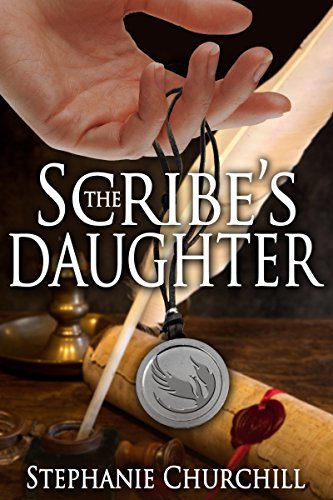 Kassia is a thief and a soon-to-be oath breaker. Armed with only a reckless wit and sheer bravado, seventeen-year-old Kassia barely scrapes out a life with her older sister in a back-alley of the market district of the Imperial city of Corium. When a stranger shows up at her market stall, offering her work for which she is utterly unqualified, Kassia cautiously takes him on. Very soon however, she finds herself embroiled in a mystery involving a usurped foreign throne and a vengeful nobleman. Most intriguing of all, she discovers clues to the disappearance of her father three years prior. When Kassia is forced to flee her home, suffering extreme hardship, danger and personal trauma along the way, she feels powerless to control what happens around her. Rewarding revelations concerning the mysteries of her family’s past are tempered by the reality of a future she doesn’t want. In the end, Kassia discovers an unyielding inner strength, and that contrary to her prior beliefs, she is not defined by external things -- she discovers that she is worthy to be loved.
Kassia is a thief and a soon-to-be oath breaker. Armed with only a reckless wit and sheer bravado, seventeen-year-old Kassia barely scrapes out a life with her older sister in a back-alley of the market district of the Imperial city of Corium. When a stranger shows up at her market stall, offering her work for which she is utterly unqualified, Kassia cautiously takes him on. Very soon however, she finds herself embroiled in a mystery involving a usurped foreign throne and a vengeful nobleman. Most intriguing of all, she discovers clues to the disappearance of her father three years prior. When Kassia is forced to flee her home, suffering extreme hardship, danger and personal trauma along the way, she feels powerless to control what happens around her. Rewarding revelations concerning the mysteries of her family’s past are tempered by the reality of a future she doesn’t want. In the end, Kassia discovers an unyielding inner strength, and that contrary to her prior beliefs, she is not defined by external things -- she discovers that she is worthy to be loved.What did I think of the book?
There are some books that you can disappear into, lose track of time and become completely embroiled in the world that the author has created — The Scribe's Daughter is one of those books.
Ms Churchill has created a masterpiece of historical fantasy. Told in the first person, The Scribe’s Daughter tells the story of seventeen-year-old Kassia, a poverty-stricken orphan, who has mastered the art of thievery to ensure that she keeps bread on the table. She is very protective of her older sister who doesn't seem to understand the seriousness of their situation — there is no money for rent, let alone food. So when a stranger offers Kassia a job and gives her a bag of coins, her poverty forces her to accept it, even though her head is telling her not to. But in doing so, she seals her fate and the world that she knows will be lost to her. Along the way, she will meet friends and foes alike. She will suffer loss, abuse and hardship, but she will also discover just how strong and courageous she really is and maybe, just maybe, she will find everlasting love when she least expects it.
What I really loved about this book was the realism. There was nothing unbelievable about this story. There are some very upsetting scenes in The Scribe's Daughter, but Ms Churchill made some really good choices — this author knows where to draw the line. Some terrible things happen to Kassia, but we don't read about them. What we do read is the emotional and physical recovery, which isn't an overnight thing. Kassia is very human. She doesn't get up, brush herself off and be done with it. She suffers, but she is a courageous soul and has an iron will that will not be beaten into submission.
Kassia is a very strong female lead that I couldn't help but admire. Faced with incredible trials and adversary she somehow finds the strength to carry on. Kassia got under my skin, she was so real in the telling, and so very believable that it was hard to think of her as a fictional character!
As a secondary character, I thought Jack was wonderful. An unlikely friend who very soon became Kassia's rock. He gives her hope, acceptance and reassurance when she has moments of doubt. He gets her, like no one else does. I loved reading how their relationship developed over the course of the book.
Despite the terrible things that happen in this book, it isn't a depressing read. Kassia is the source of much humour. She is very good with words, and she is a master at sarcasm! Some of her one-liners certainly made me laugh out loud.
The prose of the story is well-thought out. Make no mistakes; A Scribe’s Daughter is a compelling read and time certainly flew by while I lost myself within the pages. The plot is super engaging and throws up one or two unexpected curve-balls! I so didn't see where this book was going.
The Scribe’s Daughter is an example of historical fantasy at its best, but don't take my word for it, check it out for yourself.
I Highly Recommend.
Links for PurchaseAmazon USAmazonUK
About the author

I used to live my life as an unsuspecting part of the reading public. Spending my days in a Georgetown law firm just outside downtown Washington, D.C., by all outward appearances I was a paralegal working in international trade and then antitrust law. I liked books, and I read them often, but that's all I was: a reader of books.
When my husband and I got married, I moved to the Minneapolis metro area and found work as a corporate paralegal, specializing in corporate formation, mergers & acquisitions, and corporate finance. Again, by all outward appearances, I was a paralegal and a reader of books.
And then one day, while on my lunch break, I visited the neighboring Barnes & Noble and happened upon a book by author Sharon Kay Penman, and while I'd never heard of her before, I took a chance and bought the book. That day I became a reader of historical fiction.
Fast forward a dozen years or so, and I had become a rabid fan of Sharon Kay Penman's books as well as historical fiction in general. Because of a casual comment she'd made on social media, I wrote Ms. Penman a ridiculously long review of her latest book, Lionheart. As a result of that review, she asked me what would become the most life-changing question: "Have you ever thought about writing?" And The Scribe's Daughter was born.
When I'm not writing or taxiing my two children to school or other activities, I'm likely walking Cozmo, our dog or reading another book to review. The rest of my time is spent trying to survive the murderous intentions of Minnesota's w
Published on February 23, 2017 12:36
The Coffee Pot Book Club
The Coffee Pot Book Club (formally Myths, Legends, Books, and Coffee Pots) was founded in 2015. Our goal was to create a platform that would help Historical Fiction, Historical Romance and Historical
The Coffee Pot Book Club (formally Myths, Legends, Books, and Coffee Pots) was founded in 2015. Our goal was to create a platform that would help Historical Fiction, Historical Romance and Historical Fantasy authors promote their books and find that sometimes elusive audience. The Coffee Pot Book Club soon became the place for readers to meet new authors (both traditionally published and independently) and discover their fabulous books.
...more
...more
- Mary Anne Yarde's profile
- 159 followers



